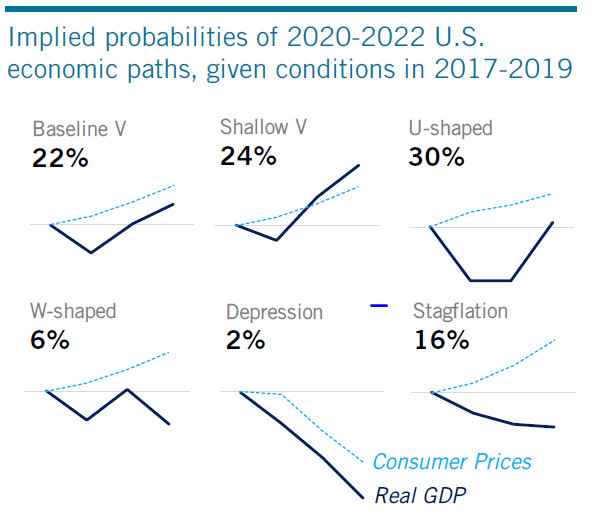This research is a collaboration between GIC, Windham Capital Management and State Street Associates. For the full research paper, please click on the “Save As PDF” button.
Constructing portfolios with scenarios in mind
Given today’s highly uncertain environment, scenario-based analysis and portfolio construction have gained huge popularity among institutional investors. As outlined in the new research paper “Portfolio Choice with Path-Dependent Scenarios”, we have developed a new systematic approach to scenario analysis that enables investors to consider their sequential impacts on portfolio risk and performance.
We illustrate the technique by evaluating alternative scenarios for the aftermath of the COVID-19 induced economic downturn. Extrapolating from relevant historical data, a U-shaped recession appears the most probable for the next 3 years with a 30% probability, followed by V-shaped recoveries at around 20% each, and 16% for a stagflation scenario. The least likely outcomes are a deep depression and W-shaped recession (see Figure below). As the COVID-19 crisis has been unprecedented in so many ways, agreeing on these results will be challenging. The key is to come up with an objective baseline and alternatives for discussion and debate.

Source: “Portfolio Choice with Path-Dependent Preferences.” Implied probabilities are based on US economic data since 1927, are derived from statistical likelihoods of path sequences, and are scaled to sum to one for the set of six scenarios considered.
In this framework, we propose for investors to first define their prospective scenarios, not as average values of the economic variables, but as paths for these variables. Second, measure the likelihood that these paths will prevail in the future based on their statistical similarity to the historical sequences of these variables, using a statistic called the Mahalanobis distance. Third, employ a forecasting technique called partial sample regression to map the economic outcomes onto the asset class returns. With a rich set of results generated from this systematic, consistent and coherent framework, investors can better evaluate and construct portfolios tailored to their preferences.
Given an outlook of uncharted policy making, changing capital market dynamics, globalization headwinds and rising geopolitical tensions, investors recognise the importance of using scenarios to address the increasing uncertainty and wide range of investment outcomes. Scenarios are not just about destinations, they are also about paths leading to these destinations. Our innovative approach of modeling paths of scenarios, instead of average values, offers a quantitative, data-driven and objective evaluation of return opportunities, downside risks and their probabilities. This will help improve the quality of debate and discussion that has often taken place only qualitatively and subjectively, and will assist investors in their assessment of risk-return trade-offs and preferences in portfolio design.
Contributed by: Mark Kritzman (Windham Capital Management), Ding Li and Grace Tiantian Qiu (GIC), David Turkington (State Street Associates)







